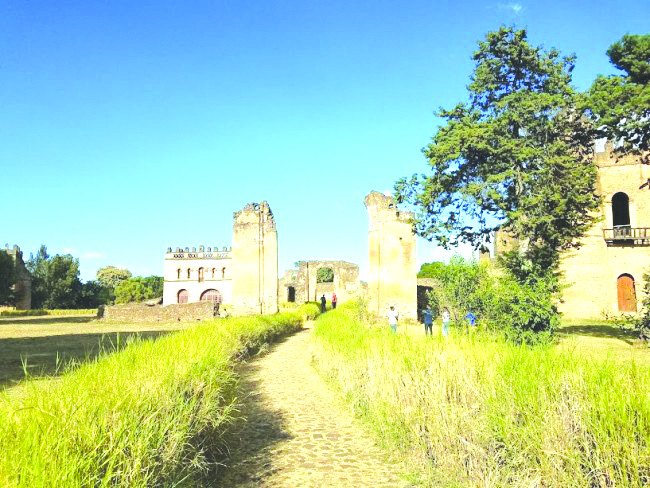
COMPILED BY LEULSEGED WORKU
The name “Ethiopia” derives from the Greek ethio , meaning “burned” and pia , meaning “face”: the land of burned-faced peoples. Aeschylus described Ethiopia as a “land far off, a nation of black men.” Homer depicted Ethiopians as pious and favored by the gods. These conceptions of Ethiopia were geographically vague.
In the late nineteenth century, Emperor Menelik II expanded the country’s borders to their present configuration. In March 1896, Italian troops attempted to enter Ethiopia forcibly and were routed by Emperor Menelik II’s army. The battle of Adwa was the only victory of an African army over a European army during the partitioning of Africa which preserved the country’s independence. Ethiopia is the only African country never to have been colonized, although an Italian occupation occurred from 1936 to 1941.
In addition to the monarchy, whose imperial line can be traced to King Solomon and the Queen of Sheba, the Ethiopian Orthodox Church was a major force in that, in combination with the political system, it fostered nationalism with its geographic center in the highlands. The combination of church and state was an indissoluble alliance that controlled the nation from King Ezana’s adoption of Christianity in 333 until the overthrow of Haile Selassie in 1974. A socialist government (the Derge) known for its brutality governed the nation until 1991.
Ethiopia is the tenth largest country in Africa, covering 439,580 square miles (1,138,512 square kilometers) and is the major constituent of the landmass known as the Horn of Africa. It is bordered on the northern and northeast by Eritrea, on the east by Djibouti and Somalia, on the south by Kenya, and on the west and southwest by Sudan.
The central plateau, known as the highlands, is surrounded on three sides by desert with a significantly lower elevation. The plateau is between six thousand and ten thousand feet above sea level, with the highest peak being Ras Deshan, the fourth-tallest mountain in Africa. Addis Ababa is the third-highest capital city in the world.
The Great Rift Valley (known for discoveries of early hominids such as Lucy, whose bones reside in the Ethiopian National Museum) bisects the central plateau. The valley extends southwest through the country and includes the Danakil Depression, a desert containing the lowest dry point on the earth. In the highlands is Lake Tana, the source of the Blue Nile, which supplies the great majority of water to the Nile River Valley in Egypt.
Variation in altitude results in dramatic climatic variation. Some peaks in the Semien Mountains receive periodic snowfall, while the average temperature of the Danakil is 120 degrees Fahrenheit in the day time. The high central plateau is mild, with a mean average temperature of 62 degrees Fahrenheit.
The bulk of the rain in the highlands falls in the major rainy season from mid-June to mid-September, with an average of forty inches of rain during that season. A minor rainy season occurs from February to April. The northeastern provinces of Tigray and Wolo are prone to drought, which tends to occur about once every ten years. The remainder of the year is generally dry.
There are eighty-six known indigenous languages in Ethiopia: eighty-two spoken and four extinct. The vast majority of the languages spoken in the country can be classified within three families of the Afro-Asiatic super language family: the Semitic, Cushitic, and Omotic. Semitic-language speakers predominantly live in the highlands in the center and north. Cushitic-language speakers live in the highlands and lowlands of the south-central region as well as in the north-central area. Omotic speakers live predominantly in the south. The Nilo-Saharan super language family accounts for about 2 percent of the population, and these languages are spoken near the Sudanese border.
History and Ethnic Relations: Ethiopia was home to some of the earliest hominid populations and possibly the region where Homo erectus evolved and expanded out of Africa to populate Eurasia 1.8 million years ago. The most notable paleoanthropological find in the country was “Lucy,” a female Australopithicus afarensis discovered in 1974 and referred to as Dinqnesh (“you are marvelous”) by Ethiopians.
The rise of sizable populations with a writing system dates back to at least 800 B.C.E. Proto-Ethiopian script inlaid on stone tablets has been found in the highlands, notably in the town of Yeha. The origin of this civilization is a point of contention. The traditional theory states that immigrants from the Arabian peninsula settled in northern Ethiopia, bringing with them their language, proto-Ethiopian (or Sabean), which has also been discovered on the eastern side of the Red Sea.
This theory of the origin of Ethiopian civilization is being challenged. A new theory states that both sides of the Red Sea were a single cultural unit and that the rise of civilization in the Ethiopian highlands was not a product of diffusion and colonization from southern Arabia but a cultural exchange in which the people of Ethiopia played a vital and active role. During this time period, waterways such as the Red Sea were virtual highways, resulting in cultural and economic exchange. The Red Sea connected people on both coasts and produced a single cultural unit that included Ethiopia and Yemen, which over time diverged into different cultures. It is only in Ethiopia that proto-Ethiopian script developed and survives today in Ge’ez, Tigrean, and Amharic.
In the first century C.E., the ancient city of Axum became a political, economic, and cultural center in the region. The Axumites dominated the Red Sea trade by the third century. By the fourth century they were one of only four nations in the world, along with Rome, Persia, and the Kushan Kingdom in northern India, to issue gold coinage.
In 333, Emperor Ezana and his court adopted Christianity; this was the same year the Roman Emperor Constantine converted. The Axumites and the Romans became economic partners who controlled the Red Sea and Mediterranean Sea trades, respectively.
Axum flourished through the sixth century, when Emperor Kaleb conquered much of the Arabian peninsula. However, the Axumite Empire eventually declined as a result of the spread of Islam, resulting in a loss of control over the Red Sea as well as a depletion of natural resources in the region that left the environment unable to support the population. The political center shifted southward to the mountains of Lasta (now Lalibela).
Around 1150, a new dynasty arose in the mountains of Lasta. This dynasty was called the Zagwe and controlled much of northern Ethiopia from 1150 until 1270. The Zagwe claimed descendency from Moses, using genealogy to establish their legitimacy, a characteristic of traditional Ethiopian politics.
The Zagwe were unable to forge national unity, and squabbling over political power led to a decline in the dynasty’s authority. A small Christian kingdom in northern Shewa challenged the Zagwe politically and economically in the thirteenth century. The Shewans were led by Yekunno Amlak, who killed the Zagwe king and proclaimed himself emperor. It was Yekunno Amlak who forged national unity and began constructing the nation.
National Identity: Most historians regard Yekunno Amlak as the founder of the Solomonic dynasty. In the process of legitimizing his rule, the emperor reproduced and possibly created the Kebra Nagast (Glory of the Kings) , which is regarded as the national epic. The Glory of the Kings is a blend of local and oral traditions, Old and New Testament themes, apocryphal text, and Jewish and Muslim commentaries. The epic was compiled by six Tigrean scribes, who claimed to have translated the text from Arabic into Ge’ez. Contained within its central narrative is the account of Solomon and Sheba, an elaborate version of the story found in I Kings of the Bible. In the Ethiopian version, King Solomon and the Queen of Sheba have a child named Menelik (whose name is derived from the Hebrew ben-melech meaning “son of the king”), who establishes a duplicate Jewish empire in Ethiopia. In establishing this empire, Menelik I brings the Ark of the Covenant with him, along with the eldest sons of the Israeli nobles. He is crowned the first emperor of Ethiopia, the founder of the Solomonic dynasty.
(Source: https://www.everyculture.com/Cr-Ga/Ethiopia.html)
The Ethiopian Herald January 9 /2021




